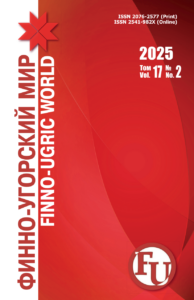Original article
DOI: 10.15507/2076-2577.013.2021.03.308-320
Fabric semantics as a basis of Mordovian embroidery
Tatyana A. Shigurova
National Research Mordovia State University,
Saransk, Russia
Introduction. The semantics of the fabric of the traditional costume is one of the underdeveloped topics in modern humanitarian studies. Meanwhile, the fabric can be interpreted as a chronicle of the history of culture. Being a man-made and material on which embroidery arose and developed, it was used in the customs and rituals of many peoples, including the Mordovians. The article deals with the semantics of the fabric of traditional Mordovian clothing, decorated with embroidery.
Materials and Methods. The work investigates the museum collections of the Republic of Mordovia, the data from written sources of the Russian Geographical Society, archaeological research of Mordovian artefacts. The methodological basis is the comparative-historical, structural-semiotic and phenomenological approaches to the material.
Results and Discussion. The analysis of the semantics of the fabric, decorated with the embroidery, and the conditions in which it was formed, makes it possible to reveal the intention of the master, the creator of the ethnoculture. It defined the various utilitarian, magical functions performed by canvas (hemp) and linen fabrics of traditional Mordovian clothing in the culture of the people, the economic, moral meanings of the fabric used in oral folk art. The Mordovians had woolen fabric as the most important material that replaced leather and fur in the manufacture of clothing and changed the appearance of the person wearing the costume. Its importance was recorded in many concepts of the Mordovian language, in folk ideas about wool as a source of magical properties.
Conclusion. The semantics of the fabric of a traditional Mordovian costume reflects a person’s ideas about harsh natural conditions, the real world and the need to master it through creative activity in accordance with the laws of the traditional worldview. Fabric is also capable of transferring updated and relevant symbolic information about diligence, accuracy, moral qualities of a person, which could also be a means of regulating norms of behavior in society.
Keywords: Mordovian people, ethnic culture, creative activity, tradition, values of ethnoculture, traditional costume, material, fabric semantics, embroidery
For citation: Shigurova TA. Fabric semantics as a basis of Mordovian embroidery. Finno-ugorskii mir = Finno-Ugric World. 2021;13;3:308–320. (In Russ.). DOI: 10.15507/2076-2577.013.2021.03.308-320.
Information about the author
Т. А. Shigurova – Doctor of Cultural Studies, Professor, Department of Cultural Studies and Library and Information Resources, National Research Mordovia State University,
shigurova_tatyana@mail.ru, https://orcid.org/0000-0001-5342-8471






















